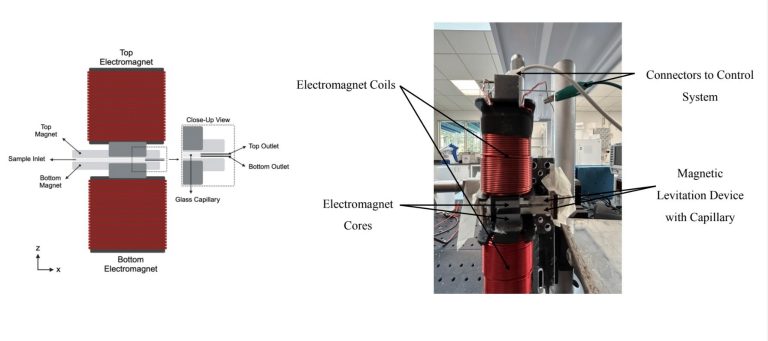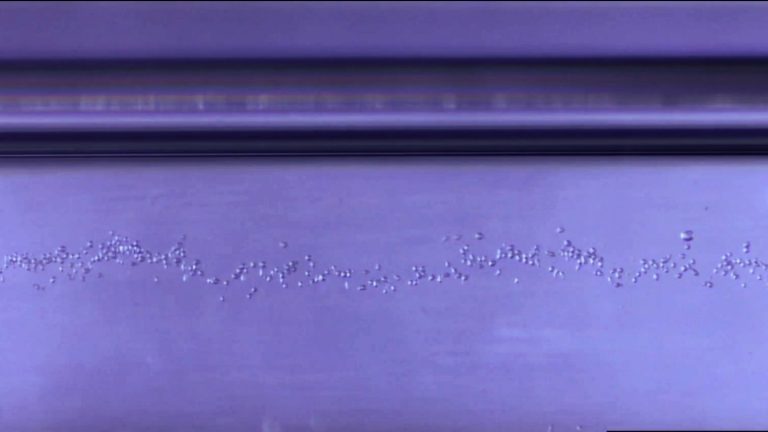Although the magnetic levitation system described in the 2015 paper allowed researchers to visually distinguish different types of cells, the differences were often too small to practically sort the cells. The setup was also static, meaning there was no way to adjust the conditions during an experiment.
“After you levitated a cell, if you wanted to levitate it further, you needed to prepare a new sample to adjust the paramagnetic properties. That was a challenge,” Durmus said.
Changing the current
The new device adds electromagnetic coils to both magnets. By adjusting the electric current running through the coils, the researchers can instantaneously modify the magnetic force applied to the cells.
“With our current design, you can very precisely manipulate the cells to separate them further,” Durmus said.

The Electro-LEV system. Courtesy Durmus Lab
Cells levitating at distinct heights are sorted as they flow out of the capillary, which branches into a top outlet and bottom outlet.
“If the sorting is not going well, you just change the current,” Durmus said. “Everything is under your control in real time, so it’s more user-friendly.”
Dead or alive
In the new study, the researchers demonstrated that Electro-LEV could fine-tune the levitation of a variety of cell types, including breast cancer cells, lung cancer cells, fibroblasts and white blood cells.
They then tested the system’s ability to tackle a common problem in the preparation of biological samples — separating live cells from dead cells. For accurate single-cell RNA sequencing and drug toxicity screening, for example, dead cells need to be weeded out. And in stem cell transplantation, dead cells can trigger dangerous inflammatory responses.
Luckily, dead cells don’t fly as high as live ones. “Once cells are dead, usually their cell membranes are damaged and they are more leaky, so they take up more paramagnetic solution and become more dense,” Durmus said.
When the researchers began with a sample of 50% live cells, they found that Electro-LEV could sort live and dead cells well enough to achieve a sample of about 93% live cells. Even with a starting sample of only 10% live cells, Electro-LEV could achieve a sample of about 70% live cells.
The system may even have the potential to sort cells of similar density. The researchers discovered that, compared with single cancer cells, clusters of cancer cells reacted more quickly to changes in the magnetic field. That’s because single cells have more surface area relative to their volume and experience more drag force. The phenomenon suggests that levitation speed could be a way to monitor for clusters of cancer cells, which tend to be more aggressive and more likely to cause metastasis, Durmus said.
She envisions far-ranging applications for electromagnetic levitation, sorting everything from cancer cells to microbes, assembling cells into organoids or even directing microrobots.
“It’s a broad, versatile platform,” Durmus said. “I think there will be applications that we haven’t even thought of yet.”
A researcher from Ozyegin University in Turkey contributed to the work.
The study received funding from the Burroughs Wellcome Foundation, the Gordon and Betty Moore Foundation, the Donald E. and Delia B. Baxter Foundation, and the McCormick and Gabilian Faculty Award from Stanford University.

